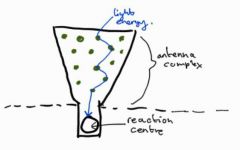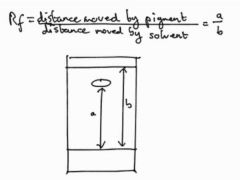![]()
![]()
![]()
Use LEFT and RIGHT arrow keys to navigate between flashcards;
Use UP and DOWN arrow keys to flip the card;
H to show hint;
A reads text to speech;
30 Cards in this Set
- Front
- Back
|
Where does photosynthesis occur and in what cells are these structures present? |
Chloroplasts located in mesophyll and guard cells. |
|
|
What are examples of chlorophylls and which regions of the spectrum do they absorb? |
Chlorophyll A and B, they absorb light in the red and blue/violet region. |
|
|
Examples of carotenoids and region of the spectrum they absorb. |
Carotene and xanthophyll, only blue/violet region. |
|
|
What does the absorption spectrum indicate? |
Amount of light absorbed at each particular wavelength. |
|
|
What does the action spectrum indicate? |
The amount of photosynthesis happening at each particular wavelength. |
|
|
Why is it on advantage for a plant to have more than 1 type of pigment? |
As each pigment absorbs light at different wavelengths, with more pigment, more of the natural light can be utilized,more photosynthesis can take place and the plant will be more efficient. |
|
|
What is the function of the antenna complex? |
To trap light energy then channel it down to the reaction centre. It contains the carotenoids. |
|
|
What makes up the reaction centre? |
Chlorophyll A |
|
|
What is the structure of a photo system? |

|
|
|
How do you calculate the Rf value? |

|
|
|
Where does the light stage take place? |
On the inner thylakoid membrane |
|
|
What happens during the light stage? |
Light energy is trapped in photosystem II and boosts electrons from the reaction centre to a higher energy level where the electrons are accepted by an electron acceptor on the thylakoid membrane. The electrons are then passed by a series of carriers to photosystem I, the energy lost in this process is captured and converts ADP into ATP. This means light energy has been converted into electrical energy. Light energy is absorbed by photosystem I and this boosts electrons to an even higher energy level where they are accepted by another electron acceptor. The electrons previously lost from the chlorophyll are replaced by electrons from the splitting of water. The protons from the splitting of water combine with NADP to make NADPH which is used in the dark stage. Some of the electrons from the 2nd electron acceptor can pass back to the chlorophyll and this gives ATP only and is called cyclic photo phosphorylation. |
|
|
Define the term immigration |
Movement of individuals into a population. |
|
|
Define the term emmigration. |
Permanent movement of individuals out of a population. |
|
|
What is migration? |
Periodic seasonal movement |
|
|
What are density dependent factors which affect population size? |
Accumulation of waste, disease, parasitism and possibly food supply. |
|
|
What are density independent factors which affect population size? |
Usually due to a sudden or extreme change in an abiotic factor such as a fire, flood or freezing. |
|
|
What is a population fluctuation? |
The numbers of a species lie near an equilibrium point known as a set point which is the specific point that an environment can support. If a population rises above this point, a density dependent factor increases mortality or reduces breeding so population decreases. If it falls below this point, environmental resistance is temporarily relieved so the population rises again. |
|
|
What do plants compete for? |
Light, space, water and nutrients |
|
|
What do animals compete for? |
Food, shelter, space and reproductive partners. |
|
|
What is intraspecific competition? |
Competition between individuals of the same species. |
|
|
What is interspecific competition? |
Competition between individuals of different species. In the long term, 2 species cannot occupy the same niche in a specific habitat. |
|
|
What is a pest? |
Something that feeds on crops and animals, competes with crops for resources, causes disease in crops, make infection by pathogens more likely and can spoil food when stored or transported. |
|
|
What is chemical control? |
The use of poisonous chemicals to control organisms considered harmful to agriculture or organisms involved in disease transmission. e.g. herbicides, fungicides and insecticides. |
|
|
What are the advantages of chemical control? |
effective, eradicate pests relatively quickly and cheaply, can be applied on a small scale and application does not require high levels of ... |
|
|
What are the disadvantages of chemical control? |
Not specific so can eradicate beneficial insects such as bees or biological control agents, pests may become resistant, some pesticides may kill mammals, birds, fish by contaminating their food and long term exposure can harm humans. |
|
|
What is biological control? |
The exploitation of predator-prey relationships by humans. |
|
|
Why is it not wise to eradicate the pest completely with biological control? |
There would be no food for the predator which would die out, then pest may reemerge later with no predators. |
|
|
What is the most successful form of biological control and why? |
When native predators or parasites have been used because sometimes non-native predators have become a pest themselves. |
|
|
What are the advantages of biological control? |
Usually specific to one pest, long term control if population equilibrium established, in the long term inexpensive, there is no environmental contamination and can be used in glass houses. |

